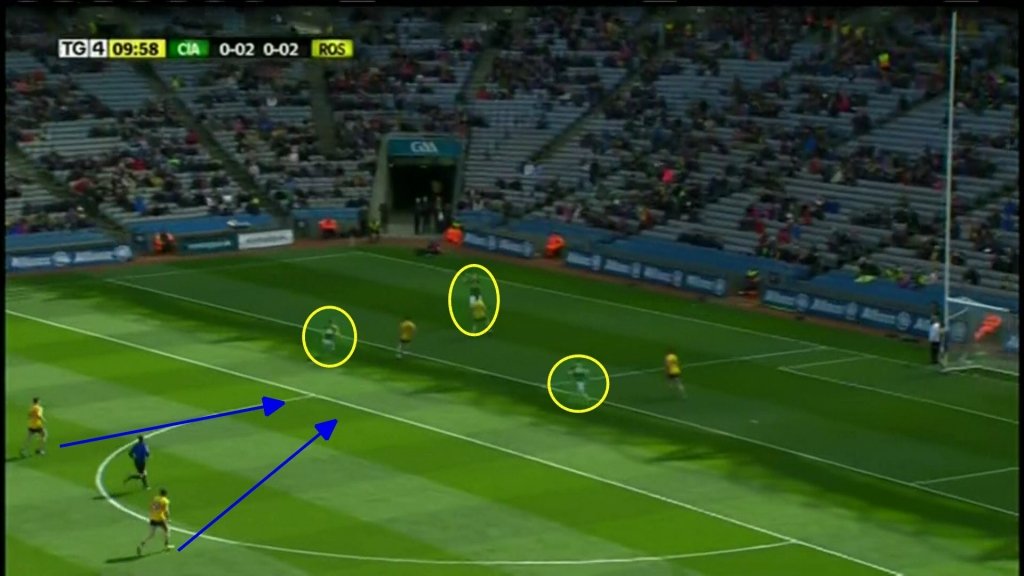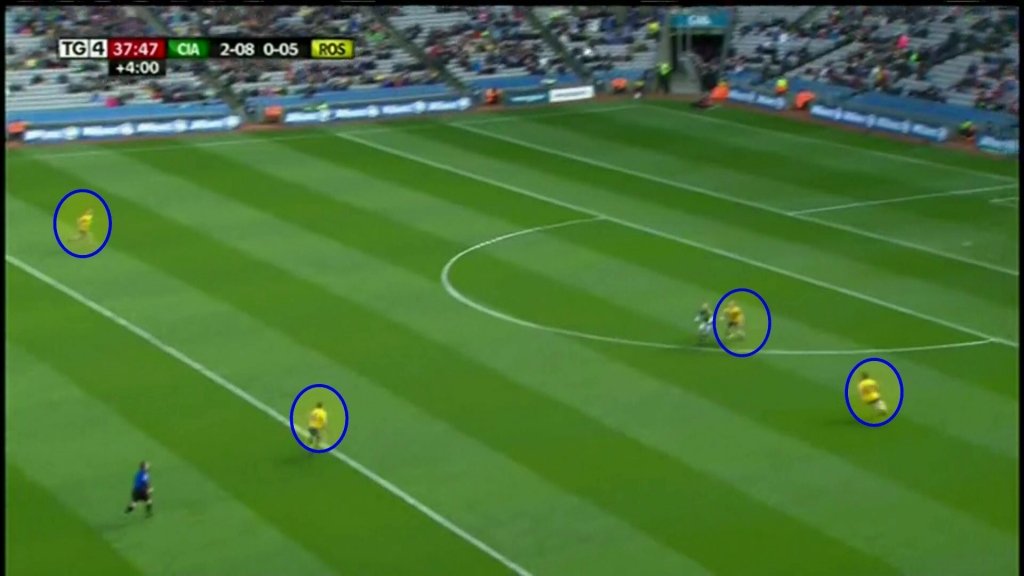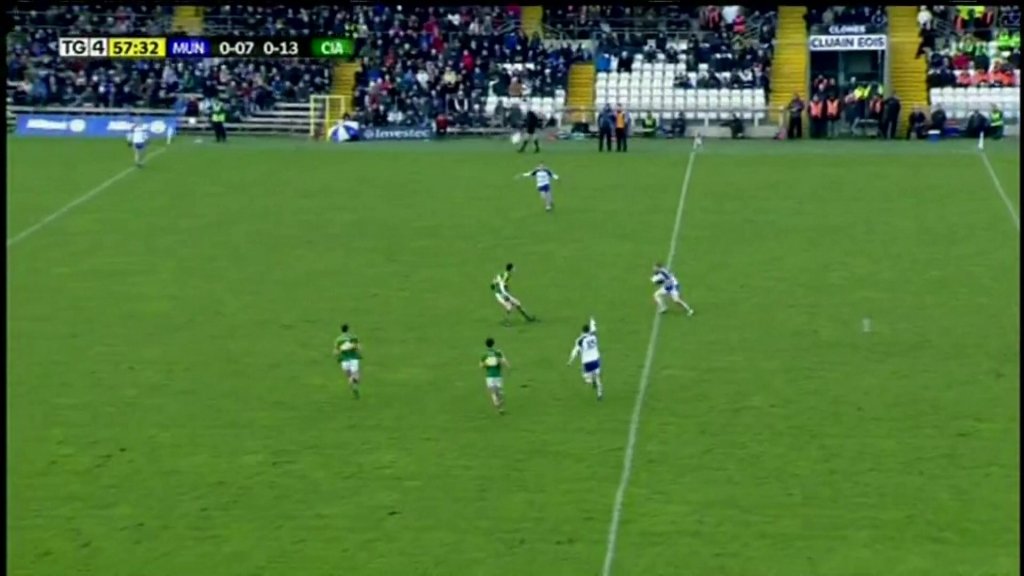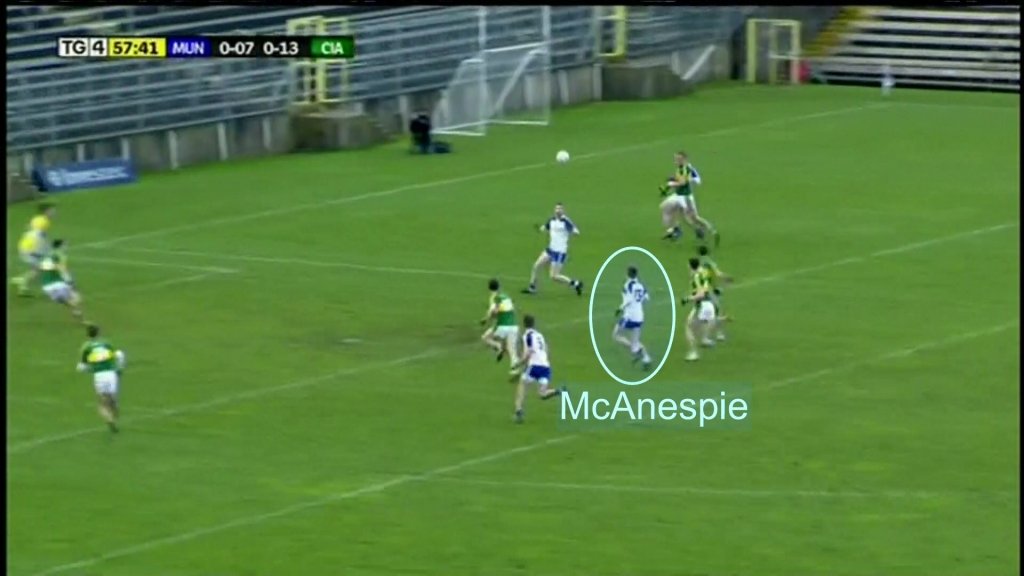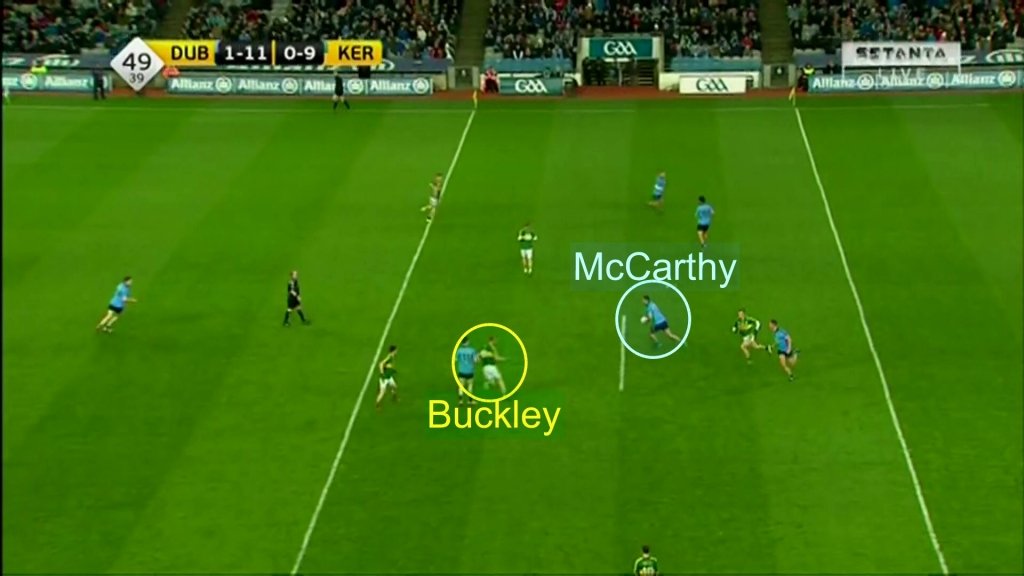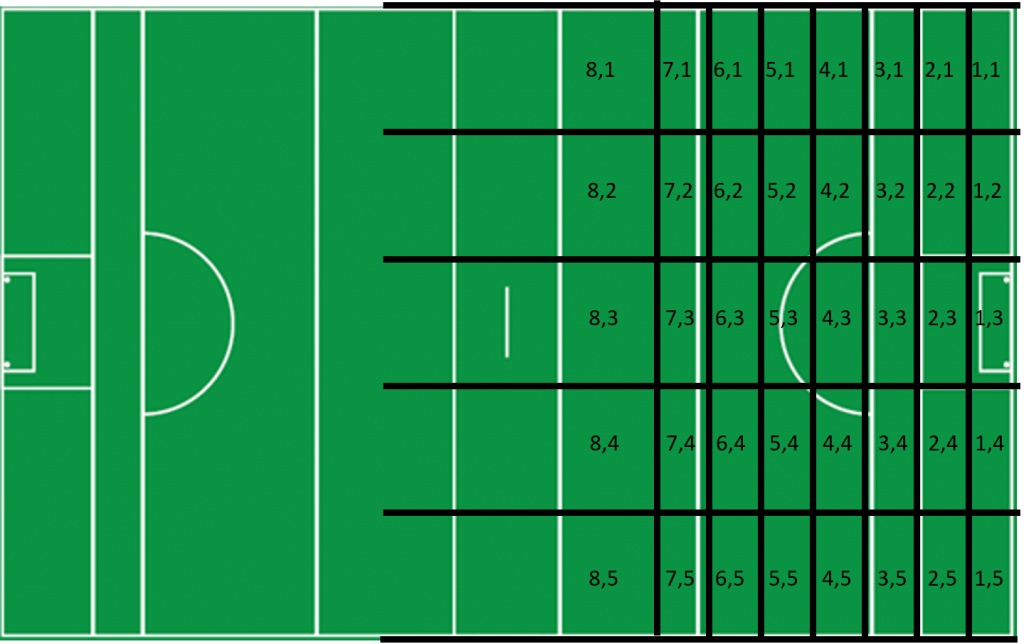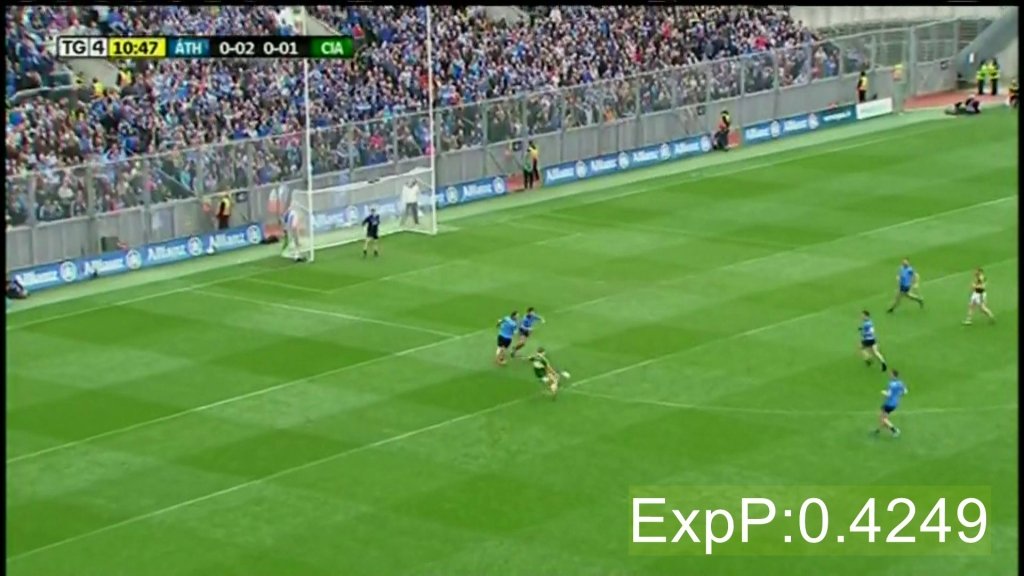Check out how each county has performed against every other county.
Kerry v Tipp, What to expect from the Kingdom
Prior to the league final there was little doubt that the Div 1 final was pitting the two form teams in the country against each other. They are the most recent all Ireland finalists, #’s 1 & 2 in the Division and both had impressive 10-point win’s in their respective semi-finals.
Kerry were on a 6 game unbeaten run, which is impressive, but far inferior when compared to Dublin’s league and Championship run at the time of 21 games unbeaten (now 24).
After a slow start Kerry have really hit their strides in the league. They boasted the 2nd best defensive record in Division 1 and were just a point off Roscommon in being top scorers at the other end. People will never tire of taking pics of the ‘traditional’ teams with 14 & 15 men behind the ball, but the best teams are adaptable. Both Dublin and Kerry played without a full-time sweeper in the first half of their semi-final’s, but when playing against a strong breeze and with a lead to protect Aidan O’Mahony and Cian O’Sullivan stayed at home. I think the best teams have the ability to adapt to what’s in front of them rather than go in with a complete script of how they are going to play.
A few months on from the league final and many people will have pushed Dublin even further ahead of Kerry both teams have yet to be tested and Sunday may not offer any clues to where Kerry are but below are a few thoughts in what we saw from Kerry in the league and some weaknesses Tipp might try to exploit
Donaghy
Kerry’s use of Kieran Donaghy will be interesting to watch as the season progresses. Although playing much more of a role in midfield throughout the league, especially for kickouts, he is not afraid to drift into the full-forward line when appropriate.
In this example we can see Kerry have just won the ball from a Roscommon Kickout. As the play develops Donaghy makes his way in to the full forward line.
Perhaps spotting a mis-match or that Roscommon are slow in getting a sweeper in place. He finds himself behind the Roscommon defenders and there is now a 3 v 3 situation inside. It’s a fantastic pass to pick him out.
Not only does he field the high ball but as he lays it off you will see how well he screens the players and makes the scoring opportunity even easier.

By simply holding his ground after laying off the pass he manages to occupy 3 Roscommon defenders.
Kieran Donaghy will no doubt have license to get himself into these situations when the opportunity arises, regardless of where he is named on the team sheet.
Kick Passing
When we look at the stats over the league season Kerry don’t kick pass it the most (that prize goes to Dublin) and they are also not the most accurate (Donegal) but I think Kerry will be happy with those numbers. There is a danger in aiming for perfect, in that you never try anything that might open a defence. Paralysis by Analysis is often quoted, and sometimes that can be right. Teams need to be less obsessed with possession counts and passing % and look at how often players made the best decision with what was in front of them. Sometimes the risk is worth the possible turnover.
Kerry seem to have a good balance, where players like David Moran or Bryan Sheehan are not hauled off for giving away possession once or twice. They are free to play balls in and the Kerry management seem happy with the risk.
Take this example from the semi-final v’s Roscommon. Injury time is almost up at the end of the 1st half. Bryan Sheehan, not content to play out the half, takes a quick sideline ball and gets the ball back.
With pressure on and time running out you would forgive Sheehan for turning back and keeping possession with a simple hand pass. However clearly unburdened by possession % stats he tries an ambitious kick pass.
This is not Donaghy or Tommy Walsh he is trying to hit here but rather Darran O’Sullivan, who has no support at all. There is a large slice of luck involved and the defender gets his timing all wrong, but the point remains, how many teams and players look at that situation inside and are paralysed by losing possession and simply turn back and play an easy hand-pass.
Instead the ball breaks and O’Sullivan slots in Kerry’s 3rd goal and puts any chance of a 2nd half comeback beyond doubt.
Running at Kerry
One weakness Kerry do show is when they are attacked straight down the middle. The 2 goals they conceded against Dublin and the 1 against Monaghan are prime examples.
From a short kickout that actually lands inside Monaghan’s 21, they eventually get to half-way. This is by no means a fast attack and Kerry should have plenty of time to set-up defensively.
Kieran Hughes just puts the head down and runs straight at the Kerry midfield and defence. Kerry seem like they have the numbers in place but Ryan McAnespie just ghost through as if they are not there.
He breaks through 3 tackles on his way to set-up what is a very soft goal to concede.
The two Dublin goals (regular season) will also worry Kerry, we will just take a look a the second goal they conceded that night. Aidan O’Mahony didn’t play and his presence at the heart of the defence was missed.
James McCarthy picks the ball up in midfield. Keep an eye as we step through this firstly how costly a momentary lapse in concentration is for Johnny Buckley but also how little cover is inside for Kerry.
Dublin have a great attacking shape here. 2 Men wide and 1 on the D. It’s a great kick pass that forces the last Kerry defender to come out from in front of the goal. As the Dublin player on the far wings holds his position it leaves an enormous gap down the middle. Buckley is 5 yards off and because there is no cover there is real danger.
As the pass is played to McCarthy you can see how open Kerry are. Without some sort of sweeper (permanent or roving) this is the danger of man v man defence. A well timed kick pass coupled with a well organised attacking unit will exploit these gaps.
As I mentioned at the top of the piece Aidan O’Mahony spent the entire second half of the semi-final camped at sweeper never venturing very far. Maybe they won’t need that type of cover against Tipp on Sunday, but come Agust someone will be filling that role for Kerry.
The Defensive Revolution
There is an Iker Casillas quote that seems to sum up much of the narrative around Gaelic Football at the moment.
Most kids dream of scoring the perfect goal, I’ve always dreamed of stopping it
While there are no doubt some kids around the world who dream like Iker, the majority want to score them. Likewise I imagine there are very few kids who are dreaming of playing in a blanket defence. Sure they will take the county jersey if it comes, but most want to do the scoring not stop it.
Fans will talk longer about the great forwards of the game, than the great defenders. The prestigious Ballon d’Or has had only 3 vaguley defensive winners since 1976 and the last true defender to win Footballer of the year was Marc O’Se in 2007.
In The Numbers Game, authors Chris Anderson and David Sally discuss the two histories of football;
One is a tale of wonderful players, of ingenuity and guile and wizardry, constantly finding new ways to improve on (what at the time looks like) perfection.
And there is a second history, one of the men who did all they could to stop them. Not the defenders, but the managers, who dreamed up catenaccio and zonal marking and the sweeper system, all of it designed to stop the virtuosos showcasing their talents. Even the tiki-taka style honed and perfected by Barcelona and adopted by Spain has been labeled a primarily defensive approach—passenaccio—because its emphasis is on starving the opposition of the ball.
Players have improved as the game has matured: They run faster, they shoot harder, they dribble quicker, and they pass more accurately. And as they have improved, so structures have been built to contain them. These structures—offside traps, pressing, triangular passing—are the reason that goal scoring has largely withered on the vine, moving from an average of 4.5 goals per game in 1890 to 2.6 goals more than 100 years later.
In soccer there was a time when seven players on any given side were given over to attacking, with two halfbacks and one fullback. That soon morphed into the W-M formation as two attackers were pulled back, and then came the 4-2-4 of Hungary and Brazil, the 4-4-2 so beloved of English managers, and now, the trend is to deploy just one striker. Barcelona and Spain do not even do that, since the rise of what has been called the false nine.
Gaelic Football is going through a similar transition. Recency bias will determine that Jim McGuinness is to blame but the reality is of you read Daire Whelan’s The Mangers,a fascinating history of the tactics and thinkers that have transformed Gaelic Football you will see that the game has constantly had innovators, both in attack and defence. This ‘curse’ of the sweeper did not start or end with Jim McGuinness.
“Imitation is the sincerest form of flattery that mediocrity can pay to greatness.”
Soccer has transformed itself from a game of 7 attackers & 4 defenders to one built more on 11 attackers and 11 defenders. Gaelic Football is attempting something similar. At the later end of the season watch how many people take pictures of 15 Kerry or Dublin players defending in their own half, as if ‘look, even they are doing it’.
But soccer is a very different game. Despite all the rule changes, (offside, backpass and 3 points for a win) the goals per game has barely moved since the 70’s.

To state the obvious, not conceding guarantees you something in soccer – you can’t be beaten. Therefore it is possible for team in leagues or major competitions to approach games with the ‘we won’t concede’ mentality and that has potential to get them somewhere. In other words soccer allows you put almost all your focus on the stopping part of the game.
This is virtually impossible in Gaelic Football. You have to go back to the 1940’s to find a scoreless team. While the two sports share a lot more in terms of tactics & strategy than traditionalist would care to admit, this is a fundamental difference. The nature of Goals and Points demands that you have to have a strategy for both stopping and scoring, a fact that seems sadly lost on many teams today.
I have reproduced a similar graph as above but for Gaelic Football. It is clear in the soccer image that there was a significant shift in strategy around the 1970’s and despite all the advances in training and preparation, video analysis and coaching standards the new normal began in 1970 and hasn’t be altered since.
Here is the scoring chart for Gaelic Football over a similar time frame.

See that big drop (orange line) in 2011 and how the trend of conceding less has continued? O wait…
Despite the defensive revolution that McGuinness has apparently blighted the game with; scoring in general is on the rise year-on-year and there is no big dip like in soccer. And for the doubters who say yes the number of points being scored might be the same but that’s because teams like Dublin are doing all the scoring, well the blue line discredits that theory. The average winning margin is almost amazingly consistent since 1950.
My point with all this is two-fold. First I feel the facts should get a fair hearing. You may not like the style the game is currently being played in, but don’t confuse that with the substance of what is on the pitch. Defensive football is not leading to less scores!
Secondly to the managers and coaches. For all the effort put into defensive systems, for the lack of enjoyment the fans seem to get from this style, for the sake of attracting the exciting, ambitious players, you really need to question what value are you getting from this defensive football? Taken as a whole teams are not conceding less than before, as we can see above scoring is on the increase.
Football is not like soccer, you can’t progress by just stopping. I look forward to the next iteration of the game, I hope it goes on the attack.
Football County Squad Sizes
It’s a different game these days. Impact subs and panels that extend beyond 30. “You need a big panel of players to cope with the demands of the modern game with it’s physical demands” they say. Even rules changes now allow for more players to take the field with Black Cards and additional substitutes.
But I wonder what the evidence says. Are any of the above statements true? Are we seeing counties use more players and as a result this is to the detriment of the ‘weaker’ counties with limited playing populations.
To try and answer this question I can now delve into my Player Database which goes back to 2006 and take a look at the evolution or lack thereof of squad sizes. Granted it would be great to look through the last 125 years of squads but that will take me a bit longer to organise. For now we can use 2006 as our starting point and 10 season should give us some indication of change, if any has happened.
Average Players Used
In 2006 the average number of players used by 31 counties* was 24.3 and 10 seasons later in 2015 it’s now 25! Yes on average squads are using 1 extra player. That doesn’t seem like a big change to me and certainly doesn’t fit the narrative of this new game they are all playing. Whatever playing resources a County needed in 2006 is very similar to what they need today, as you can see from the almost flat line plotting this average over the last 10 years.
Starters v Subs
So that looks at overall how many players were used, but doesn’t really distinguish between starters/subs. So let’s look at the average number of starters counties have used and see if that has ‘evolved’ over the last decade.
2006 = 20
2015 = 19.3
So on average team used less starting players in 2015 than they did in 2006. It’s not a huge change and has hovered around that figure consistently. Counties are using 1 extra player but that’s mostly just an extra sub, the number of starting players is static.
The Have’s v Have Not’s
So we can take this a stage further, let’s look at the difference between good and bad teams. You can argue the toss over successful and unsuccessful for the last decade but let’s say it’s Dublin, Cork, Kerry and Mayo (at least 3 AI Final appearances). We can then compare those 4 teams v’s the rest to see if there is any differences of note.
Average Players Used
First point is there is very little change over time. Successful teams are using the same amount of players as they did in 2006 as are Unsuccessful teams. There does seem to be a difference of about 1 player but this gap has not widened.
Starters Comparison
Again – I can see no evidence of the evolution of bigger squad sizes. 2015 looks a lot like 2006 for both groups. The gap here again is around 1 player.
Bigger Resources = Bigger Squads = Winning ?
I think what is clear from this is that the season to season difference is negligible and even looking at the data county x county doesn’t shed any light on it either. In a single season all counties tend to use the same playing resources. So is there anything useful to be gathered from squad sizes?
The final graph I will share today is the number of individual players a county has used over the last 10 seasons. This includes starters and subs but should give an idea of player turnover in that time.
10 years is a big time frame to look at. Squads will go through transition periods but at just 58 players Kerry have used the fewest players.
Does success lead to stability or does stability lead to success? Looking at these numbers and especially looking at the above graph since 2012 it seems to me that unsuccessful teams don’t lack for players but they do seem to struggle to retain the same players. In any given year they use the same quantity of players as the best teams, the issue is not enough of them are the same players as the previous year.
A herd of buffalo can only move as fast as the slowest buffalo. The unsuccessful teams are constantly playing catch up with their new/slowest buffalo(s).
*For reference including London and New York doesn’t really change these numbers at all but for the sake of this I have left them out.
Dublin League Kickout Map
Dublin’s Kickout’s from the League 2016.
* 8 out of 9 games. The Dublin v Roscommon regular league game was not televised.
Football Tactics; Revolution or Recycle?
“It goes back to the time Clive Woodward guided England to the Rugby World Cup, it’s paralysis by analysis……. This game of Gaelic Football has been infiltrated by a load of spoofers and bluffers, people with no experience in some cases of Gaelic Football, fellas with ear pieces stuck in their ear, psychologists, statisticians, dieticians… and we’ve forgotten the basic principles of the game – the catch and kick. “ – Pat Spillane, 2013
The comments about spoofers and bluffers from Pat Spillane took place during the half-time analysis between Cavan & Fermanagh in the Ulster Championship 2013. He was angry, the game wasn’t being played how it should be, the only way to play FOOTball is with your feet. It’s a game only about catch and kick. It’s an interesting thought, maybe there is only one way football should be played. But this isn’t gymnastics, there are no points for style. Stoke City and the Crazy Gang Wimbledon of the late ‘80’s didn’t play like Barcelona or Arsenal and the traditionalists hated them too.
In fact this style of play debate was the starting point of a book ‘The Numbers Game’ by Chris Anderson & David Sally. While discussing the merits or otherwise of Rory Delap’s long throws David Sally wondered why all teams didn’t employ the same tactic. The only answer Chris Anderson (a former professional GK) could come with was ‘because there are some things you don’t want to do when playing football. Because, even though a goal celebrated by a long throw is worth just as much as one from a flowing passing move, it’s almost like it doesn’t count as much. Because, to purists, they’re are somehow not quite as deserved.’
This debate is not confined to Soccer. Almost as soon as the Galeic Games were codified it seems there was a traditional way of playing. Check out this extract from Dick Fitzgerald’s book in 1914!
‘Everybody knows that the tendency of the outdoor games of the present day is to reduce the individual player to the level of a mere automation. In a manner the individual in modern games is a disadvantage to his side if his individuality asserts itself too strongly.’
Gaelic Football history is littered with these conflicts of style. Fans get much more excited by the big high catch from a Kieran Donaghy who turns and scores then a sweeping hand passing move from one end of the pitch to the other ending in the same result. But the fact is there isn’t just one way to play football, there are loads of ways and if there is one thing that separates great minds from the rest it is the ability to question how things have been done.
Do people always get it right, no! but the questioning, development and innovation can lead to much greater things, things that weren’t envisaged by the traditionalists. All of these developments come from people who are willing to question the most common seven words in football ‘That’s the way it’s always been done.’
Billy Beane, the General Manager of the Oakland A’s and whose character Brad Pitt played in the film Moneyball was recently asked about hiring outside baseball people. When asked about one of his right-hand men, Farhan Zaidi, who has has a PhD in behavioural economics and whether that was a disadvantage Beane replied ‘he has no experience-bias when he comes to my office, so he is able to question the obvious. A guy like myself, who has been in the game his entire life, may not be able to spot when the emperor is not wearing any clothes.”
Far from an outsider but still one of the most recent innovators is Jim McGuiness. We all know the story, McGuinness took over a team that had failed to win an Ulster Championship game in 4 years. A team that had last won the All Ireland 19 years previously. He wanted to build a team that could not only compete within Ulster but go even further. No doubt he knew the players well, but even from afar he knew what he was getting when he inherited the squad. Rather than take on the likes of Kerry, Cork & Dublin at their own game (the so-called traditional game) he needed to beat them at a different game.
This was a modern day form of David v Goliath, The Oakland A’s v’s the Yankees, The Have not’s v the Have’s. David couldn’t fight Goliath with a sword, he couldn’t take him on at his own game, David had to change the rules, do something unexpected. Football teams throughout history have been doing exactly the same.
Jim McGuiness took charge of his first Ulster Championship game against Antrim in 2011 on a very wet May day in Ballybofey. It was the only game on TV that weekend and was the start of the Championship season. It was 6 points to 3 in favour of Donegal at half-time. During the half-time analysis Joe Brolly summed up the game and Donegal’s tactics as follows;
“The disease of Donegal football is solo running and hand passing, it’s a lethal cocktail which can lead to only one thing, which is boredom” Joe Brolly continued, (referring to Donegal’s style)…”that’s ok at the moment but it’s not going to be any good in terms of winning an Ulster Championship or advancing beyond that.”
Within 40 months Donegal would be 3 times Ulster Champions & visit the All Ireland Final twice, winning once, only losing 3 championship games in that time; An Ulster Final, All Ireland Semi-Final and an All Ireland Final.
I don’t quote Joe Brolly to make a mockery of his analysis, which in hindsight couldn’t have been more wrong, but rather to highlight this notion that there is only one way to play football. This is not a unique situation to Gaelic Games, all sports seem to have a ‘right’ & ‘wrong’ way to play the game. But history has shown that that has never been the case. Just as ‘new’ coaching and training methods are developed there is an ebb and flow to tactics and strategies, history has shown that not unlike the catwalks of Milan or New York there is a reinvention every season and while it is often heralded as a revolution, when you look a bit closer it seems more like recycling than revolution.
2016 will require something different from the challengers. While it would be wrong to call Mayo, Monaghan, Kerry, Donegal or Tyrone David’s they are going to need to recycle or re-invent something about their game to find a way to topple the Dublin Goliath.
Expected Points
Good Artists Copy; Great Artists Steal
If you follow any of the soccer analysts you will constantly hear the term Expected Goals. Soccer is a low scoring game and Expected goals is a better way to both accurately reflect a players true scoring value and also how many he is likely to score in the future given the same opportunities. It turns out that simply looking at how many goals a player scored in one season is not a good prediction of how many he will score next season and the season after that. Expected goals is a better way to do that. Perfect? No, but better. And when you are buying players for £50m+ every little helps.
You can find out a little more about the soccer versions and their rational by reading this summary post – which links to all the mains models. http://mackayanalytics.nl/2016/03/28/how-good-are-our-xg-models/
Gaelic Football Expected Points (ExpP).
While soccer is low scoring, with relatively few shots, Gaelic Football is not. Therefore what the sport lacks in # of games it ‘sort of’ makes up for in the number of shots and scores per game. James over on the blog dontfoul gives a very good account of his model here and it’s well worth reading. Our models are not identical but the fundamentals are the same and from some of the results I’ve seen the outcome is very very similar.
ExpP is a pretty simple concept. You effectively break the pitch into scoring zones. In my case I use 40 zones. 5 from touchline-to-touchline and 8 zones progressing approximately every 7 meters.
So you take all the shots from a given location (let’s say there are 100 from a certain location and 50 of them have been converted for points). The ExpP for that zone is .5 (50/100). In my model I have over 14,000 shots across all the zones.
If a player takes 8 shots from that location in a game we would expect him (based on the average) to score 4 points. If he scores 6 he is +2 points better than the average footballer.
The models can get much more complex than this and you can build in factors such as opposition strength, # of defenders between shooter and the goal, pressure on the kicker, game state, ground (think Hill 16) and so on. For now I’m going to run with the simple version above.
So we take out 14,000 shots. Divide them up into the 40 zones, break them down if they were from play, from placed ball or from a penalty. For each zone and shot type we get an ExpP number. Every time someone takes a shot from that location we can compare him or his team to what we would expect.
In Action
Spurred on by Richard Whitall doing something similar for soccer on his new site frontoffice.report here is what the Expected Goals looks like against the actual chances and in it I hope to highlight while ExpP is a great way to look at players over the long run, it does have weaknesses if we just look at chance x chance or even game x game.
I’ll use the League final and just a few examples to show how this works.
Stephen O’Brien Point
You can see here that O’Brien slots what seems like an easy chance over. However we would only expect inter-county players to score this 42% of the time. So while it looks easy a score here is not a gimme.
Cormac Costello Point
Cormac Costello slots over a point from distance in the 2nd half. It’s the other side of the pitch than the example above but a very similar expected return.
Paul Flynn Goal
Paul Flynn’s goal happens in zone 2;3. I’ve recorded 596 shots from play from that zone. 152 goals have been scored and 167 points. This means that from this location (ignoring all other factors) we would expect a team to score just over 1 point (1.045 to be exact)* for every attempt.
I think we can all agree that the ExpP model is underestimating how good a chance this is. Despite my belief that ExpP is a great way to look at players and teams it is not without its flaws. While we wouldn’t expect Flynn to score 100% of the time, expecting him to score a goal just 33% of the time from here is underestimating him. And the following 2 images show why that is.
The model treats these 3 shots in exactly the same way i.e. they happened in the same location. Although we can see from the screen grabs that the attacker is facing very different situations in each case. In the long run Paul Flynn will attempt many shots from the location he scored the goal from on Sunday so 1.005 is accurate over his career, just not in this individual case.
ExpP is really useful when looking over the long run, a much better indicator of a players true ability, rather than just looking at Shot % or Total Scores. But this is the health warning. Looking at 1 shot or even a full game a model is going to be flawed. Teams can have an eye on the long run but ultimately deal in the here and now. That’s why video analysis is so important for them.
I’ll publish more about this during the summer and I will start to build in some other factors rather than just location but for now consider this the introduction.
We’re Hiring
We’re looking for an enthusiastic analyst to join us here at Gaelic Stats for the summer. Rather than look for CV’s and cover letters all you need to do is fill in the following application form.
You must be available to work Sunday’s, Monday’s and Tuesday’s from May to September in our offices in South Dublin.
Work will commence very soon and the closing date for applications is Friday 8th April.
Cork’s Blanket
Cork arrived with a blanket in Croke Park last Saturday evening and it seemed to work for about 35 minutes. But then Dublin caught them, passed them and gave them more headaches leaving than when they arrived. Coming into the game with the worst defensive record in the 4 divisions it’s easy to see why Cork set up with virtually all men behind the ball.
There is no getting around this, this was a scrappy and poor game overall. With 56 turnovers (29 in the first half) and 52 fouls the game never really got going. It took 11 minutes for the first point from play and Cork scored 1-1 from shots that dropped short in the first half.
The 1st half had a staggering 21 by Dublin. For some context Dublin’s average Turnover rate is 26 for an entire game. I think we can safely assume no team will get as many against Dublin again this term.
So did the game all hinge on the half-time team talk? The hairdryer treatment? I’m sure there is an element of that but there is a lot more at play that a couple of broken tea-cups in a dressing room.
Cork’s Set-up
As mentioned Cork came with the intention to get men behind the ball and park the bus. Over the last 3 weeks we have seen vastly different styles against Dublin. Mayo conducted a mix of press and drop off, Monaghan were much braver in pushing up on the kickouts and really trying to put pressure on Dublin while still effectively playing with 2 sweepers. Cork did the 3rd option. They defended in numbers. Early on you can see they have +3 defenders in place which forces Dublin to go lateral time and time again. In this example Ciaran Kilkenny has no option but to head back across the pitch.
We can see in an earlier play (below) how well Cork were set-up defensively. Costello receives the ball under the Hogan and his first thought is to look up and find someone inside. We can’t see from the camera angle but nothing is on inside.
So he cuts inside, plays a 1-2 and looks to change the point of attack.
He does find a nice ball to Brogan, but Brogan receives the ball 45m + out and again Cork have +2 defenders against the 2 Dublin forwards and a sweeper arriving behind them.
Brogan is forced to try a fairly impossible shot with no other Dublin Forwards in sight. Of Dublin’s 21 1st Half turnovers 17 were misplaced kick passes. Whether they weren’t reading the sweepers or simply ran out of options is hard to tell.
Dublin Switching Play
Against a blanket defense Dublin constantly look to change the point of attack. They are great at keeping their width and even though they struggled in the first half they were always looking to switch the play. Cork switched off for a couple of minutes in the first half and Dublin were able to see the opening.
Cork win a sideline ball but have no options so end up kicking it away in the middle of the park.
Cooper picks it up and immediately keeps the ball coming towards the near touchline. A nice interchange with Cian O’Sullivan opens up the play, but the Cork players are slow to react to losing the ball. I think the 3 men highlighted on the far side could be quicker to react to the danger. All 3 effectively walk back towards position.
For the first time in the half there is no sweeper in place and Dublin can play the ball into Brogan and have men running off. If the 3 men highlighted above were quicker in getting back it would have (possibly) allowed everyone to shift around a bit more and for Brian O’Driscoll cover that space in front of Brogan and Andrews.
Connolly finishes the goal really well but I want to highlight the defending of Brian O’Driscoll. As he is running full-tilt towards Brogan he seems too preoccupied with marking the inside runner, Paul Flynn. He could have read the situation a bit better and saw that Cork had 4 men inside to take Flynn. There is no need for him to keep tracking that run.
He almost has to break his stride to get out of Brogan’s way. The danger here is the man on the ball and he would have been better served stopping any release.
He makes a valiant effort to get back put those split second decisions are crucial against Dublin.
A Game to Two Halves
So what changed in the 2nd half? Other than the tea-cups being thrown, there were some positional switches with McCarthy going into Midfield and being 7 points down players feel they have more license to take risks. Phily McMahon barely ventured forward in the first half but he kept appearing off the shoulder and making runs into Cork’s 45. Even in the last minute of the game as James McCarthy coolly slotted the ball into the net the player waiting in the square for a pass was McMahon.
It’s hard to see McMahon not being given a license to venture forward in games given his recent form and the Mayo game.
Cork’s blanket was still in place for the majority of the 2nd half but some costly errors in front of Dublin’s goal early in the 2nd half killed their momentum and the scoreable frees Cork conceded allowed Dublin edge ahead without much fuss.
It took Cork 9 Attempts to get their first score of the 2nd Half. The 3rd miss coming when Cork still had a 5 point advantage 5 minutes into the 2nd half.

What will probably disappoint Cork the most is the easy chances they coughed up from scoreable frees. Dublin kicked 10 points from 11 placed balls for a 90% return. In contrast they kicked 6 from 16 attempts from play (albeit 2 goals). But that is a 38% return from play. The fouling really kept Dublin in the game.
With 55 mins gone Cork still lead by a goal (2-7 to 1-7). For Dublin’s remaining 7 points only one was from play. Cork coughed up 6 frees in those remaining 15 minutes. For the blanket to work the discipline is so important. In the end as much as Dublin upped the ante Cork let them off the hook by allowing them keep the scoreboard ticking over.

